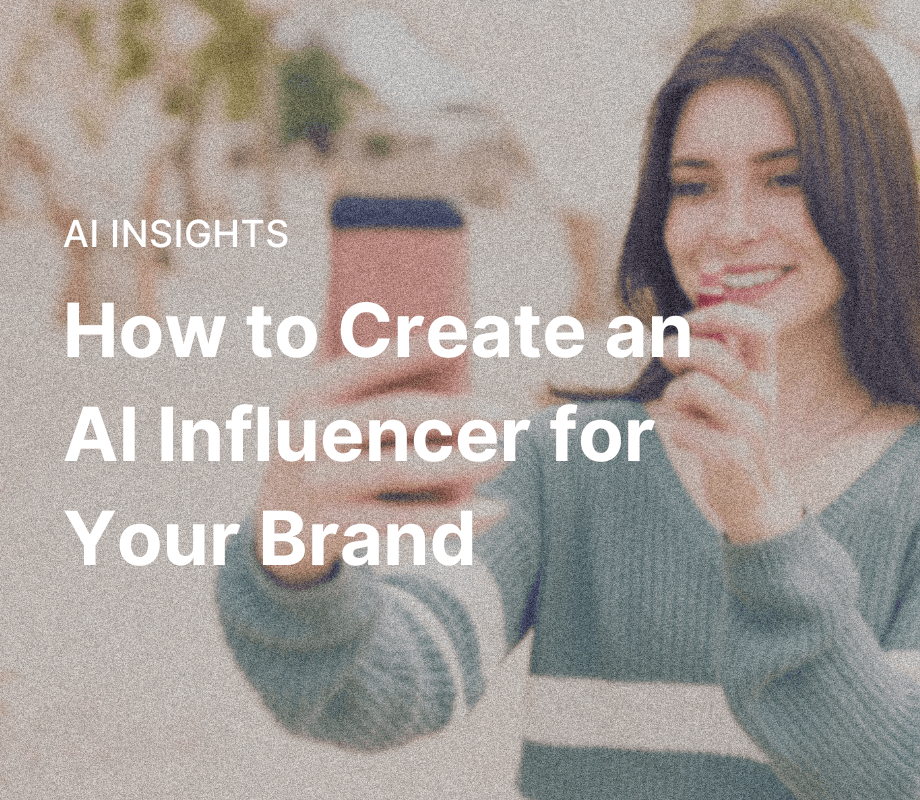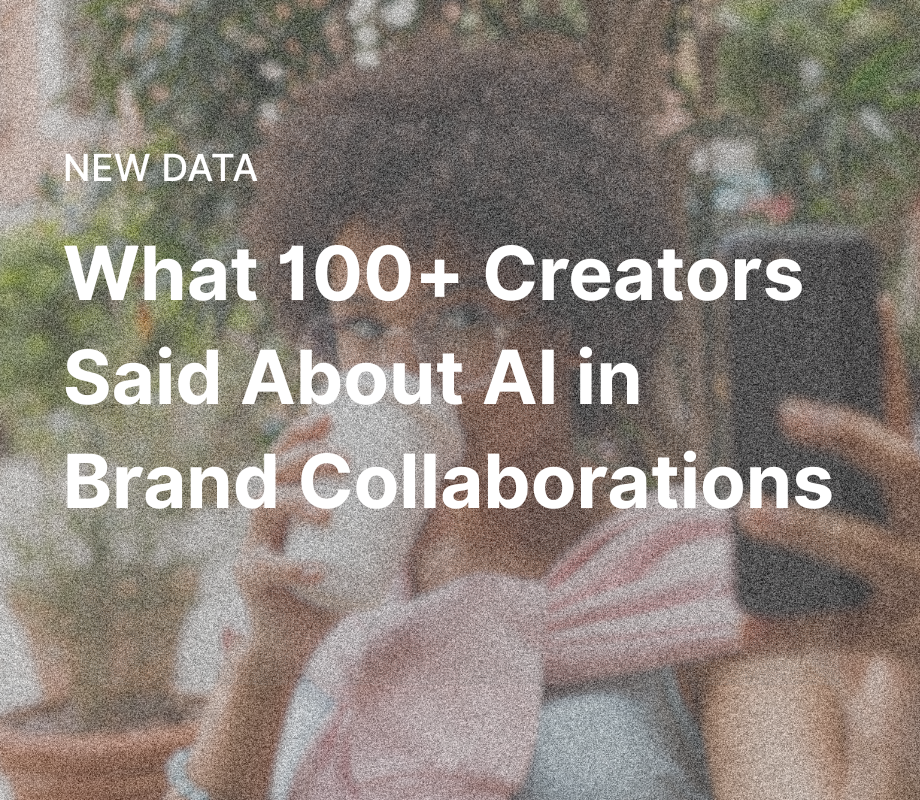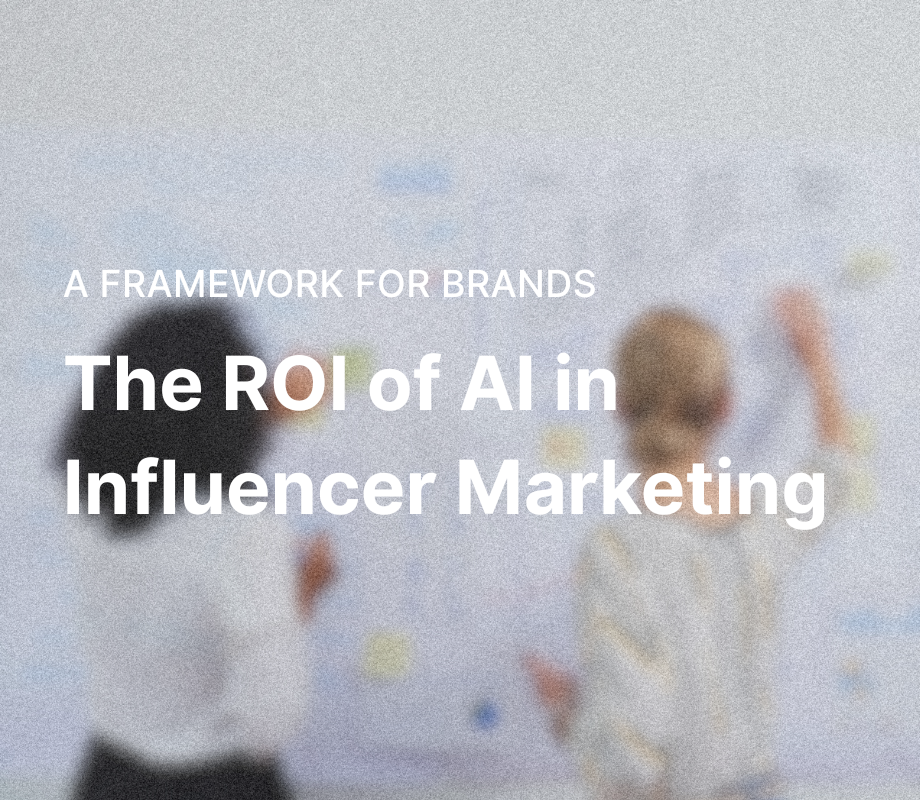Using celebrities, public figures, and athletes to promote brands is nothing new. With the rise of social media, the influencer pool has exploded, giving companies endless options when using tools like the "find influencers tool." However, finding a trustworthy person who aligns with your brand’s values and speaks to your target audience isn't always easy. Recently, new developments in technology have given rise to an alternative approach: artificial intelligence in influencer marketing.
The use of AI influencers has allowed brands to reach markets around the world and interact with users in multiple languages. They stick to brand messaging and avoid controversial statements and actions that human influencers may make by mistake. AI influencers are becoming increasingly common, so it’s essential to know exactly what they are and how they can help your brand meet its marketing goals.
Table of Contents
- What is an AI influencer?
- Benefits and drawbacks of using AI influencers
- Why AI influencers are rising in popularity
- How AI influencers are changing influencer marketing
- How to create an AI influencer for your brand
- FAQs about AI influencers
- AI influencers: A valuable addition, not a human creator replacement
What is an AI influencer?
An AI influencer is a virtual personality created with artificial intelligence and 3D modeling technology. Like human influencers, they engage audiences, promote products, and represent brands, but every piece of content and interaction they share is generated by AI.
Marketing teams create AI influencers to reflect their target audience and communicate in a brand-aligned voice. They program these digital personas with specific vocabulary, tone, and messaging to provide consistency across campaigns. Once created, these AI influencers can automatically post content, respond to comments, and interact with users across social platforms, delivering personalized, on-brand engagement at scale.
Key features of AI influencers
AI influencers share many similarities with human creators, but their capabilities go far beyond what a single person can manage. If you’re considering investing in an AI influencer to promote your brand, these are key features that you should be aware of:
Realistic visual design and human-like emotion modeling:
AI technology is so advanced today that visual designs can look identical to real human influencers. However, not all brands opt for hyper-realistic human replicas. If your brand calls for it, your AI influencer can be in the form of a cartoon, anime character, animal, or experimental design. All iterations can mimic real-life facial expressions, movement, and body language while showcasing custom clothing and accessories that match your brand aesthetic.
AI-driven voice, tone, and interaction style:
Along with the visuals, AI advancements make it possible to have custom voices that are realistic and accurate. With natural language generation, you can fine-tune cadence, tone, and even language for different markets. This customization helps your influencer sound authentic and localized wherever your audience is.
Consistent content production:
By automating content and posts, you won’t need to worry about generating posts, stories, and videos to appear on your AI influencer’s channel. Determine the frequency at which you’d like content to appear and leave your AI bot to it. This also means you can scale the volume of output quickly to respond to trending topics or high demand.
Customizable brand alignment for tone and values:
Each AI influencer is programmed with your brand's tone, values, and vocabulary. This creates on-message communication and eliminates risks like off-brand statements or public missteps. You can also design a personality that resonates with your target audience, building a stronger emotional connection.
Managed by teams or automated AI systems:
Once you launch an AI influencer, you can still make adjustments and control aspects of their interactions. While you can automate AI systems to generate new content and interact with users, you can also make adjustments to adjustments and interaction strategies as needed. Marketing teams can also manually edit posts to tailor content for specific reasons.
How AI influencers are created
Creating an AI influencer depends on a combination of digital tools. For example, brands use design tools to alter the fashion and visual style of the AI bot. Generative AI allows them to produce authentic speech, text, and content. Machine learning algorithms let the AI interact and engage with the audience over time.
Understanding the process of creating an AI influencer can help you efficiently build one that connects with your audience. Here’s a breakdown of what takes place during the creative process:
Concept development:
Start by defining your influencer's purpose. Before creating the AI influencer itself, you need to know how it will propel your company to reach its goals. With your target audience in mind, decide on the identity, characteristics, and backstory of the influencer you want to create. Then determine how it will fit into the larger brand strategy and marketing campaigns.
Visual design:
Bring your AI avatar to life through 3D models or CGI avatars. You’ll need to design everything from their appearance, visual style, environment, and clothing. Make sure your visual decisions resonate with your audience and align with your brand’s values.
AI training:
Large language models can take sample text and create a customized persona for your AI influencer. Provide a mock speech that uses your desired voice, vocabulary, and writing styles, so it reflects your brand’s values.
Personality tuning:
Your AI influencer needs a relatable backstory that resonates with your target audience. The past you give it shapes how they interact with users, so it should align with your brand’s values and messaging.
Social automation:
Determine which platforms your target audience uses, such as Instagram or TikTok. Then automate your AI bot to begin posting content and responding to comments and DMs from users.
Performance monitoring:
Keep an eye on key metrics like likes, reach, and watch time. Make adjustments to your AI influencer, the frequency of their posts, and the type of content they’re posting to maximize efficiency.
Whether you decide to use an AI or a human influencer, using platforms like Later helps you track performance and ROI in real time. You can monitor engagement, compare results, and optimize every campaign for stronger outcomes.
Benefits and drawbacks of using AI influencers
Before creating your own AI influencer to represent your brand, it’s vital to know the advantages and potential challenges. Knowing the pros and cons helps you decide whether investing in an AI influencer aligns with your marketing strategy.
Pros
AI influencers are gaining traction in the digital marketing space, making it easier to communicate with users at any time and projecting brand messages internationally. Here are five of the top benefits of AI influencers:
Available 24/7:
AI influencers don’t need to sleep or take breaks, so they’re always online. They can post content, respond to comments, and engage audiences at any hour, making them accessible to international followers across all time zones.
No off-message risks:
AI bots follow the brand tone, values, and messaging you provide. This means their output can be more predictable than human influencers, and they are less likely to cause controversies or say something off-brand.
Cost-effective long-term:
After the initial investment, AI influencers can create a massive amount of content without recurring costs. You can also scale to reach international audiences and use multiple languages cheaper than hiring multiple human influencers.
Data-driven personalization:
With accurate data, you can program AI influencers to deliver different messages to different audiences. Adjust the visual style and voice to align with different cultures or demographics. You can also personalize the messaging to engage specific niche audiences, guaranteeing highly personalized engagement.
Innovation appeal:
AI influencers are a cutting-edge trend, and those interested in technology will likely respond positively. Taking advantage of this new tech can position your brand as a pioneer in your industry.
Cons
While there is a lot of upside to the new technology, there are several limitations that still exist. Here are some of the challenges companies will deal with when using an AI influencer to promote their brand:
Limited authenticity:
AI influencers can engage audiences, but they don't have real emotions. Unlike human influencers, who draw from lived experiences, AI interactions can feel calculated or artificial.
Requires transparency:
Using an AI influence and not disclosing that it is a bot can have harsh consequences. If you use one, you must be upfront with your audience and clearly state that the influencer they are interacting with is not human.
High initial costs:
Building a high-quality AI influencer that reflects your brand requires significant upfront investment. While low-cost or free options exist, professional 3D modeling, generative AI training, and polished designs come at a premium.
No true spontaneity:
AI influencers can respond and interact to questions and conversations in real time. However, they struggle with spontaneous reactions that emulate emotions like surprise or humor, which can come across as scripted or manufactured.
Why AI influencers are rising in popularity
The emergence of AI influencers has quickly gained popularity among brands that want to take advantage of marketing that is both personalized and geared toward targeted audiences. AI-driven campaigns allow brands to tailor messaging to micro-segments, making every interaction feel relevant and engaging. More and more, companies see traditional marketing methods, such as print advertisements, television commercials, and emails, as less effective. While using human influencers to connect with individuals, AI influencers can fill in the gaps of some of their limitations. They can simultaneously manage multiple campaigns and adapt content based on audience insights, something difficult for human teams to execute at scale.
Brands that use AI influencers can control the message being put out and scale it with ease. These AI bots don’t ever need breaks, which leads to around-the-clock engagement in all time zones around the world. World-famous brands such as Prada, Samsung, and Dior have already taken the initiative to experiment with these virtual influencer marketing campaigns. More companies are following suit, with the virtual influencer market projected to surpass $6 billion by 2027.
Previously, this technology was mostly accessible to large corporations with big budgets. Today, smaller brands can leverage AI tools to create virtual ambassadors affordably. Industries such as fashion, beauty, gaming, and entertainment particularly benefit, since visuals and identity play a central role in audience engagement.
How AI influencers are changing influencer marketing
Marketing that relies on product recommendations from trusted sources dates back to the 18th century, but influencer marketing as we know it exploded with social media, giving everyday people opportunities to build followings and partner with brands. Companies quickly realized they could leverage human creators to reach audiences, drive engagement, and promote products. Now, AI is reshaping the field once again. It introduces new possibilities for scale, precision, and personalized storytelling that were previously impossible with only human-only campaigns.
AI influencers stretch the limits of what creator marketing means as it combines technology, storytelling, and personalization at scale. The AI influencer campaigns produce massive amounts of consistent brand imagery and messaging. Analytics gathered from AI influencers allows marketing professionals to make data-driven decisions that hone in on niche audiences and potential customer bases.
Later Influence, a high-end marketing solution, makes it easy to track engagement and compare AI vs. human influencer campaign results in real time. Later also provides a library of downloadable resources that help marketers maximize the efficiency of their influencer campaigns.
How to create an AI influencer for your brand
AI influencers can help your brand engage audiences and attract potential customers, but creating an effective one takes more than a few clicks. You need to give your AI influencer a clear purpose, a distinct personality, a visual style, and train it with AI models. Most importantly, it must fit seamlessly into your overall marketing strategy.
By following these steps, you can make sure your AI influencer checks all the boxes and is ready for your company’s marketing campaigns.
Define your campaign goals:
Social media marketing campaigns can focus on areas such as increasing brand awareness, building engaging communities, or converting sales. Knowing your goals from the start allows you to train your AI influencer to deliver measurable results.
Develop an influencer persona:
Your target audience must relate to your AI influencer. This means you’ll need to create a persona that matches the age, gender, values, and interests of those watching. Using similar language and crafting a similar backstory builds trust and strong connections with viewers.
Design visuals:
The way your AI influencer looks is a big part of gaining interest. With 3D modeling or avatar generation tools such as Unreal Engine and MetaHuman, you can control how your AI bot appears. Decide if you want a hyper-realistic, anime-style, or cartoon representative, what clothes they’ll wear, the expressions they’ll make, and more.
Train the AI:
Create mock posts and speech that match the character you want to create. This should include the tone, vocabulary, and responses that match your brand. Feed these examples into a large language model AI that can scale them and build a persona for your AI influencer.
Set up automation:
With AI influencers, you don’t need to manually post content and engage with users. By automating your engagement and social media posts, you can sit back and let your AI bot handle the rest. Make sure to connect to an
for accurate performance tracking.
Monitor performance:
No matter how well you set up your AI influencer, you’ll still want to keep an eye on how it’s performance and make adjustments accordingly. Use analytics tools like Later Influencer to follow metrics like EMV, engagement, and ROI.
Building an AI influencer from scratch is possible, but it demands a lot of time, effort, and money. Another route you can take is partnering with an existing AI influencer agency or creator to simplify the process.
FAQs about AI influencers
How do AI influencers interact with followers?
AI influencers can interact with users in several different ways, such as DMs, posts, comments, and live streams. Brands program AI influencers to deliver messaging with a preferred tone and vocabulary to make sure messaging aligns with the brand's voice. While these AI bots can deliver automated personalized responses through natural language models, human moderators can also supervise exchanges with fans.
Are AI influencers ethical?
Yes, AI influencers are ethical as long as brands are up front and honest that followers are not engaging with a human. Brands that use AI influencers to deceive users into thinking they aren’t interacting with AI bots can face intense backlash and damage the trust of the community.
Will AI influencers replace human influencers?
No, AI influencers won’t replace human influencers. Users can better connect to human influencers because of their relatable experiences, empathy, and spontaneous interactions. AI influencers complement human creators and handle predictable or brand-controlled content.
What industries use AI influencers the most?
AI influencers work well with industries that easily pair with brands and promote products. Currently, fashion, beauty, gaming, tech, and entertainment are industries that are taking advantage of the new wave of AI influencers. These industries rely on visual appeal and content trends that can take advantage of the strengths of AI influencers.
How much does it cost to create an AI influencer?
Creating a worthwhile AI influencer requires a large upfront investment from a company. Depending on the complexity, realism, and efficiency of the custom AI influencer, brands can pay anywhere from $10,000 to $300,000.
AI influencers: A valuable addition, not a human creator replacement
As new technology debuts, new opportunities come about. The arrival of AI influencers allows brands to redefine brand storytelling and engage new audiences around the globe. While AI influencers cannot replace genuine human interaction and connection, brands can use them to expand to new markets and deliver personalized engagement to potential customers and fans.
Using a trusted influencer campaign platform, such as Later, can help you get the most out of your efforts and investments. Later allows you to manage both AI and human influencer campaigns easily, so you can put your time and effort toward other areas of your business.
Book a free demo today and learn how Later can help optimize your brand’s marketing strategy.




